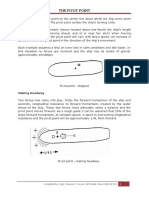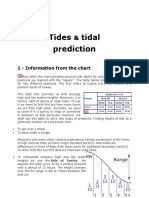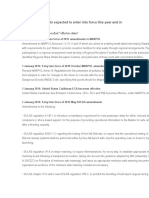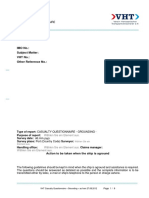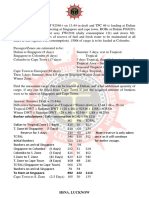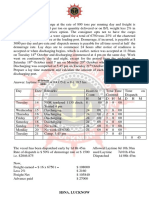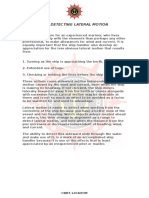0 ratings0% found this document useful (0 votes)
740 viewsCurving and Recurving of T.R.S.
Curving and Recurving of T.R.S.
Uploaded by
bittu692Tropical cyclones like hurricanes have angular momentum relative to the Earth's rotation axis. This causes them to precess as they move with the Earth's rotation. This precession subjects them to a global torque that accelerates them toward the pole in their hemisphere. As they move to higher latitudes while conserving their angular momentum relative to the Earth's axis, they also accelerate eastward, causing hurricanes to initially move west but then recurve and turn north and east.
Copyright:
© All Rights Reserved
Available Formats
Download as DOCX, PDF, TXT or read online from Scribd
Curving and Recurving of T.R.S.
Curving and Recurving of T.R.S.
Uploaded by
bittu6920 ratings0% found this document useful (0 votes)
740 views1 pageTropical cyclones like hurricanes have angular momentum relative to the Earth's rotation axis. This causes them to precess as they move with the Earth's rotation. This precession subjects them to a global torque that accelerates them toward the pole in their hemisphere. As they move to higher latitudes while conserving their angular momentum relative to the Earth's axis, they also accelerate eastward, causing hurricanes to initially move west but then recurve and turn north and east.
Original Description:
why TRS curve and recurve
Copyright
© © All Rights Reserved
Available Formats
DOCX, PDF, TXT or read online from Scribd
Share this document
Did you find this document useful?
Is this content inappropriate?
Tropical cyclones like hurricanes have angular momentum relative to the Earth's rotation axis. This causes them to precess as they move with the Earth's rotation. This precession subjects them to a global torque that accelerates them toward the pole in their hemisphere. As they move to higher latitudes while conserving their angular momentum relative to the Earth's axis, they also accelerate eastward, causing hurricanes to initially move west but then recurve and turn north and east.
Copyright:
© All Rights Reserved
Available Formats
Download as DOCX, PDF, TXT or read online from Scribd
Download as docx, pdf, or txt
0 ratings0% found this document useful (0 votes)
740 views1 pageCurving and Recurving of T.R.S.
Curving and Recurving of T.R.S.
Uploaded by
bittu692Tropical cyclones like hurricanes have angular momentum relative to the Earth's rotation axis. This causes them to precess as they move with the Earth's rotation. This precession subjects them to a global torque that accelerates them toward the pole in their hemisphere. As they move to higher latitudes while conserving their angular momentum relative to the Earth's axis, they also accelerate eastward, causing hurricanes to initially move west but then recurve and turn north and east.
Copyright:
© All Rights Reserved
Available Formats
Download as DOCX, PDF, TXT or read online from Scribd
Download as docx, pdf, or txt
You are on page 1of 1
When an entity with angular momentum about its axis, such
as a gyroscope, is subjected to a torque it precesses. If it is
forced to precess it experiences a torque. Tropical cyclones
(hurricanes, typhoons etc.) have angular moment with
respect to their axis. They turn with the Earth's rotation and
are thus forced to precess. This results in their being subject
to a global torque which accelerates them toward the Earth's
pole in their hemisphere. Hurricanes are thus accelerated
toward the North Pole.
There appears to be no other explanation of
why tropical storms move poleward.
These tropical cyclones also have angular momentum with
respect to the Earth's axis. The conservation of this angular
momentum means that as they move to higher latitudes they
experience an acceleration to the east. Thus a hurricane that
develops in the low latitude Atlantic and appears to move
west begins to turn north. It thus recurves to the east as it
moves north. A Southern Hemispheric tropical cyclone such
as an Australian one moves west and then recurves to the
southeast.
CMET. LUCKNOW
You might also like
- 2nd Mate Chart Work NumericalsDocument10 pages2nd Mate Chart Work Numericalsbittu69286% (7)
- Chief Mates Phase 2 Question Papers PDFDocument180 pagesChief Mates Phase 2 Question Papers PDFNelson Varghese100% (1)
- Magnetic Compass - Oral COCDocument10 pagesMagnetic Compass - Oral COCNaeem100% (1)
- 1.22 SSBT Assessment Set-ADocument1 page1.22 SSBT Assessment Set-Abittu692No ratings yet
- Library Books AmendedDocument4 pagesLibrary Books Amendedbittu692No ratings yet
- Gyro Simplified (S) For Phase II and Deck Officers KnowledgeDocument18 pagesGyro Simplified (S) For Phase II and Deck Officers Knowledgebittu692No ratings yet
- Isps 1 IntroductionDocument20 pagesIsps 1 Introductionbittu692100% (1)
- Explain With The Help of Suitable Diagram, The Sequential Formation of Sea IceDocument6 pagesExplain With The Help of Suitable Diagram, The Sequential Formation of Sea IceRagunath Ramasamy100% (1)
- 5 Ice On SeaDocument24 pages5 Ice On SeaMD hidtzNo ratings yet
- Danger Message Solas ch.5 Reg 31 and 32Document2 pagesDanger Message Solas ch.5 Reg 31 and 32PL BALASUBRAMANIANNo ratings yet
- Dry DockinfDocument2 pagesDry DockinfGurjit SinghNo ratings yet
- 1.meterology Phase 1Document66 pages1.meterology Phase 1Arjun AchuNo ratings yet
- Muster List, OSC Duties & IAMSAR & Duties of A LookoutDocument20 pagesMuster List, OSC Duties & IAMSAR & Duties of A LookoutYouTube paradiseNo ratings yet
- Chief Mate Phase 1 Exams Syllabus PDFDocument6 pagesChief Mate Phase 1 Exams Syllabus PDFSaurav Naskar100% (1)
- Gyro 1 PDFDocument11 pagesGyro 1 PDFAakarSingh100% (1)
- 1i Cot Due To DensityDocument2 pages1i Cot Due To DensityShankar SinghNo ratings yet
- Grounding QuestionDocument1 pageGrounding Questionarshit sharmaNo ratings yet
- Chart Work - Assignment 2Document2 pagesChart Work - Assignment 2arshit sharma100% (1)
- Ex-Meridian TablesDocument13 pagesEx-Meridian TablesBéla KovácsNo ratings yet
- Frontal Depressions1Document2 pagesFrontal Depressions1Farhan SamiNo ratings yet
- 05 Tropical Revolving StormsDocument21 pages05 Tropical Revolving StormsBhupinder Singh Jhajj100% (1)
- Magnetic CompassDocument8 pagesMagnetic CompassCriven V. ManzanoNo ratings yet
- Marine Meteorology PDFDocument49 pagesMarine Meteorology PDFMarius LazarNo ratings yet
- Phase I - Meteorology - MMD Question Paper 2022 2012Document42 pagesPhase I - Meteorology - MMD Question Paper 2022 2012Arpit MeenaNo ratings yet
- Magnetic Compass Notes-1Document10 pagesMagnetic Compass Notes-1loai allamNo ratings yet
- Dock Labour Regulations: - Who Made This RegulationDocument35 pagesDock Labour Regulations: - Who Made This RegulationAku RajNo ratings yet
- Marine Gyro Compasses For Ships OfficersDocument82 pagesMarine Gyro Compasses For Ships OfficersCarlie West100% (2)
- Special Considerations For Container ShipsDocument8 pagesSpecial Considerations For Container ShipsInsan AhammadNo ratings yet
- Egg CodeDocument3 pagesEgg CodesanjeetalkNo ratings yet
- Determining Compass Errors and Their CorrectionsDocument28 pagesDetermining Compass Errors and Their CorrectionsMaster Irvin100% (2)
- MSC.1-Circ.707 - Guidance To The Master For Avoiding DangerousSituations in Following and Quartering Seas (Secretariat) PDFDocument14 pagesMSC.1-Circ.707 - Guidance To The Master For Avoiding DangerousSituations in Following and Quartering Seas (Secretariat) PDFhugh7777No ratings yet
- Auto Pilot On Ships: Working of A Ship's Auto Pilot With SketchDocument6 pagesAuto Pilot On Ships: Working of A Ship's Auto Pilot With SketchAsus FonepadNo ratings yet
- Ph-1 TCN DGS Qs & Ans May'24 Rev3Document68 pagesPh-1 TCN DGS Qs & Ans May'24 Rev3annisharma1111No ratings yet
- Methods of Preventing Grain From ShiftingDocument4 pagesMethods of Preventing Grain From ShiftingGovinda Koshyari100% (1)
- CHAPTER 7 Timber CargoesDocument6 pagesCHAPTER 7 Timber CargoesMorganNo ratings yet
- Sea Ice ClassificationDocument10 pagesSea Ice ClassificationSuyash BagadNo ratings yet
- Maritime Legislation - SATISHDocument146 pagesMaritime Legislation - SATISHAshysh ChahalNo ratings yet
- Marine MeteorologyDocument6 pagesMarine MeteorologyAlina BarbuNo ratings yet
- Tropical Revolving StormDocument83 pagesTropical Revolving StormCarmen Darmanin0% (1)
- Magnetic Compass - The Earth'S MagnetismDocument19 pagesMagnetic Compass - The Earth'S MagnetismNaman ChaturvediNo ratings yet
- Marine Meteorology 2016Document193 pagesMarine Meteorology 2016cri100% (1)
- Position Fixing - The Most Important Element of Passage Planning - MySeaTimeDocument43 pagesPosition Fixing - The Most Important Element of Passage Planning - MySeaTimeJayprakash SinghNo ratings yet
- CH 08 Transferring Circular Position LinesDocument5 pagesCH 08 Transferring Circular Position LinesAmit PandeyNo ratings yet
- Adverse Stability: Check You Progress NameDocument3 pagesAdverse Stability: Check You Progress NameArun Ketu SethNo ratings yet
- Compass Error 01Document7 pagesCompass Error 01RAMZI OUSTAHNo ratings yet
- Gyro Compass - Basic Principle, Operation and Usage On ShipsDocument4 pagesGyro Compass - Basic Principle, Operation and Usage On ShipsGiorgi Kandelaki50% (2)
- Code Book1Document96 pagesCode Book1Mohd akifNo ratings yet
- Lesson13-Master GyroDocument8 pagesLesson13-Master GyroREYNALD TEJERONo ratings yet
- Ships & Ice: Notes On Ice NavigationDocument14 pagesShips & Ice: Notes On Ice NavigationbhabhasunilNo ratings yet
- Magnetic & Gyro CompassDocument19 pagesMagnetic & Gyro CompassIbrahem Al-Khawaja100% (1)
- Magnetic Compass-2Document17 pagesMagnetic Compass-2Parminder singh parmarNo ratings yet
- International Regulations For Preventing Collisions at Sea (COLREGS) PDFDocument20 pagesInternational Regulations For Preventing Collisions at Sea (COLREGS) PDFNairdna P Led Oirasor100% (1)
- Pivot PointDocument3 pagesPivot PointHarikrishnaNo ratings yet
- ECDIS - The Future of Navigation PDFDocument12 pagesECDIS - The Future of Navigation PDFKhushi Bhatt100% (1)
- Loading Compartment Terms: Filled TrimmedDocument17 pagesLoading Compartment Terms: Filled TrimmedNyan Min Htet100% (1)
- Unberthing Plan FormDocument2 pagesUnberthing Plan Formritxi88100% (1)
- Muster ListDocument6 pagesMuster ListSachin DubeyNo ratings yet
- Q2 G8 Science Exam ReviewerDocument3 pagesQ2 G8 Science Exam ReviewerEJAYNo ratings yet
- Earths MotionDocument21 pagesEarths MotionMYBBIGNo ratings yet
- Formation of TyphoonDocument1 pageFormation of TyphoonMary Queen TeroNo ratings yet
- HOMEWORK - Jet Stream, Rossby WavesDocument3 pagesHOMEWORK - Jet Stream, Rossby WavesSofri AyuNo ratings yet
- What Causes The Day/Night Cycle On Earth?: Flag This PhotoDocument2 pagesWhat Causes The Day/Night Cycle On Earth?: Flag This PhotoMelvin CabonegroNo ratings yet
- Temperate Cyclone Upsc Notes 42Document4 pagesTemperate Cyclone Upsc Notes 42claxmanchandelNo ratings yet
- Reviewer2nd QuarterDocument5 pagesReviewer2nd Quartergomeznixia2No ratings yet
- Tide Predictions For 2nd MateDocument5 pagesTide Predictions For 2nd Matebittu692100% (1)
- Errors of Magnetic Compass and Their CorrectionsDocument10 pagesErrors of Magnetic Compass and Their Correctionsbittu692100% (2)
- Keppler's Laws of MotionDocument4 pagesKeppler's Laws of Motionbittu692No ratings yet
- List of Amendments Expected To Enter Into Force This Year and in The Coming YearsDocument3 pagesList of Amendments Expected To Enter Into Force This Year and in The Coming Yearsbittu692No ratings yet
- Tide Questions Secondry PortDocument1 pageTide Questions Secondry Portbittu692No ratings yet
- Lesson Plan - 2MFG (Competence 1) Function I PDFDocument83 pagesLesson Plan - 2MFG (Competence 1) Function I PDFbittu692No ratings yet
- IMO No.: Subject Matter: VHT No.: Other Reference No.Document9 pagesIMO No.: Subject Matter: VHT No.: Other Reference No.bittu692No ratings yet
- Infrastructre Requirement For 10 CoursesDocument5 pagesInfrastructre Requirement For 10 Coursesbittu692No ratings yet
- Bunker Calculations (Daily Consumption HO 42 T FW 12t)Document2 pagesBunker Calculations (Daily Consumption HO 42 T FW 12t)bittu692No ratings yet
- Fire Tetrahedron and The Standard: Combustible Flammable Liquid FuelDocument1 pageFire Tetrahedron and The Standard: Combustible Flammable Liquid Fuelbittu692No ratings yet
- (Direction of Axis - 1.72 W of True North) : Hsna. LucknowDocument5 pages(Direction of Axis - 1.72 W of True North) : Hsna. Lucknowbittu692No ratings yet
- Law Relating To Maritime Wrecks in India-6Document10 pagesLaw Relating To Maritime Wrecks in India-6bittu692No ratings yet
- File No 14 Port of RefugeDocument9 pagesFile No 14 Port of Refugebittu692No ratings yet
- Question 6Document2 pagesQuestion 6bittu692100% (1)
- Time Table IMO Model Course 1.08Document2 pagesTime Table IMO Model Course 1.08bittu692No ratings yet
- Oral Syllabus For 2nd MatesDocument2 pagesOral Syllabus For 2nd Matesbittu692100% (1)
- Asm Complied Notes: Mate Receipts ClausesDocument10 pagesAsm Complied Notes: Mate Receipts Clausesbittu692No ratings yet
- Detection of Lateral Movement of ShipDocument1 pageDetection of Lateral Movement of Shipbittu692No ratings yet
- Infrastructre Requirement For 10 CoursesDocument5 pagesInfrastructre Requirement For 10 Coursesbittu692No ratings yet
- List of EquipmentsDocument6 pagesList of Equipmentsbittu692No ratings yet
- Compas CorrectionsDocument13 pagesCompas Correctionsbittu6920% (1)
- 9 - Emergency OperationsDocument10 pages9 - Emergency Operationsbittu692No ratings yet
- Overview of The ISPS CodeDocument30 pagesOverview of The ISPS Codebittu692100% (2)




















































